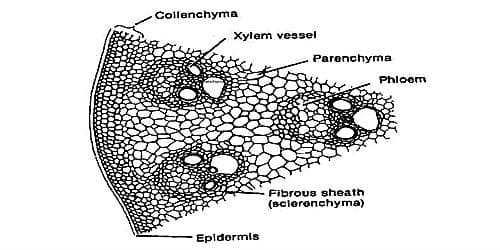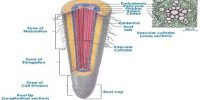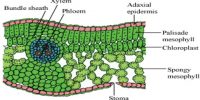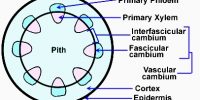The internal structure of monocot stem
Those plants whose seed contains only one cotyledon or embryonic leaf is known as simply monocot. Monocot stems have the majority of their vascular bundles near the exterior border of the stem. In this study focus on identifications of the internal structure of monocot stem.
(i) The circular stem may have depressed structures due to the presence of lateral branches. It has single layered epidermis and epidermal hairs are absent.
(ii) The Epidermis is composed of one layered parenchymatous cells and is surrounded by a thick layer of cuticle. It is the outer most single-celled thick layer. It is prepared from arranged barrel-shaped cells generally without epidermal stem hairs. It is outwardly covered by a thin layer of cuticle.
(iii) The single-layered cuticularised epidermis may contain multicellular trichomes
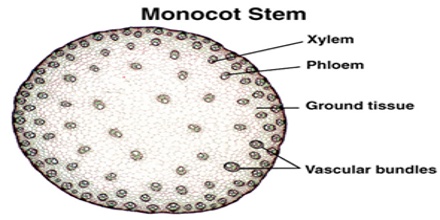
(iv) Epidermis contains stomata with guard cells. Intrastelar and extrastelar regions cannot be separated.
(v) Ground tissues are not differentiated into cortex and pith. The entire mass of parenchyma cells next to hypodermis and extending to the center is called ground tissue. These cells are smaller, polygonal, compactly arranged (toward the center) or loosely arranged (toward peripheral). It consists of thin-walled parenchymatous cells with wall to wall contact i.e., no intercellular space. The scatter vascular bundles are embedded in these tissues. These cells contain reserve materials. Ground tissues internal to hypodermis are all parenchymatous in nature showing the primary body no separation into the cortex, starch sheath, etc.
(vi) The hypodermis is usually composed of sclerenchymatous cells. Intercellular space is absent in this layer. Hypodermis of the monocotyledor stem is made up of sclerenchyma. It provides mechanical strength to the plant. It is 2-3 layered monocot stem inflexibility is more in hypoderrrus whereas in dicot stem elasticity is more.
(vii)The whole area, from the lower part of hypodermis up to the center, consisting of parenchymatous cells is called ground tissue. Intercellular space is present in this region.
(viii) Vascular bundles are more in the number and are scattered throughout the ground tissue. They are conjoint, collateral and closed. It has two types: larger and smaller and scattered in ground tissue without any order (atactostele). The large vascular bundles lie towards the center (less in number) and smaller towards and periphery (more in number). Bundles are numerous and scattered in the ground tissue, more crowded towards the periphery than towards the center.
(ix) Vascular bundle – conjoint collateral and closed type. Each vascular bundle is covered with bundle sheath made of sclerenchyma. Each vascular bundles has an oval outline and surrounded by a sclerenchymatous bundle sheath which encloses Xylem and Phloem. The bundles are collateral closed. Xylem has the usual elements.
(x) Xylem is endarch, phloem is represented only by companion cells, sieve tubes, and little phloem fibers. In xylem number of vessels is less. This cavity is created by the disintegration of the element present below the protoxylem and neighboring parenchyma. Exception: In Asparagus water cavity & bundle sheath are absent.
(xi) Phloem: It consists of sieve tube elements and companion cells. Phloem parenchyma is absent.
(xii) Pith: Pith is undifferentiated in monocotyledon stems. Atactostele is found in monocotyledon. This is a highly developed style.
